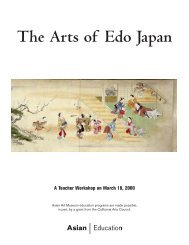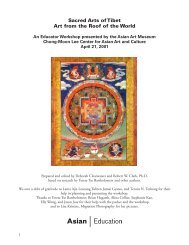Teacher Packet: Chinese Brushpainting (.pdf) - Asian Art Museum ...
Teacher Packet: Chinese Brushpainting (.pdf) - Asian Art Museum ...
Teacher Packet: Chinese Brushpainting (.pdf) - Asian Art Museum ...
Create successful ePaper yourself
Turn your PDF publications into a flip-book with our unique Google optimized e-Paper software.
Slide 15<br />
Brushstrokes: Styles and Techniques of <strong>Chinese</strong> Painting<br />
Poppies [one of twelve flower paintings]<br />
Yun Bing (act. ca. 1670-1710)<br />
Qing dynasty<br />
One of a set of 12 album leaves, colors on silk<br />
B65 D49<br />
Many bird and flower paintings, including<br />
this album of flowers painted in colors on<br />
silk by Yun Bing, were done by women artists.<br />
(Also, you may recall, the calligraphy in<br />
slide 1 was for a handscroll of ink flowers by<br />
the female artist Xue Wu.) Working in the<br />
meticulous gongbi style, she has sought to<br />
capture the details that characterize these gorgeous<br />
flowers. The flowers of various colors<br />
-- pink, red, mauve, and white -- are depicted<br />
in botanical detail, each petal articulated with<br />
its fine veins and fringed tip. Also visible are<br />
the sharp zigzag edges of the leaves, the intricacy<br />
of their veins, and how they cling tightly<br />
to the stems.<br />
While the xieyi style used by Chen Chun (slide 14) depends on swift execution and sure brushstrokes<br />
that cannot be altered by additional painting, the gongbi style used here by Yun Bing, requires infinite<br />
patience and absolute control of detail. As a form of water color, it too is unforgiving of mistakes.<br />
Each element in the picture has been built up slowly by laying down a thin layer of color wash, blending<br />
it carefully with a brush dipped in water and, after that has dried, repeating the process until the<br />
color is thick and opaque. The white pigment used as the underpainting of the rosy-edged flower was<br />
painted on the underside of the silk so that it would be less likely to soften and bleed into the pink<br />
pigment applied on the top side of the silk.<br />
In the gongbi style, the elements of the picture are often outlined first with fine, even lines and the<br />
areas then filled in with color. In this instance, however, Yun Bing appears not to have drawn the<br />
outlines but to have created them by pushing the first layer or layers of color wash delicately outward,<br />
so the pooling of the color left a slightly darker line defining the contours. Each stem likewise was<br />
outlined by the pooling of the color from the application of one sure, wet stroke. <strong>Art</strong>ists often used<br />
charcoal sketches to compose their pictures; perhaps Yun Bing sketched this picture first and followed<br />
the lines of her sketch with the color washes.<br />
Although critics, who tended to come from the scholar class, did not respect this art of rich color and<br />
fine finish, the style was practiced and enjoyed by other segments of the population, including prosperous<br />
merchants, many aristocrats, and the imperial court. Yun Bing’s paintings were much in demand,<br />
especially after one which had been given to the Empress Dowager came to the attention of the<br />
19 <strong>Asian</strong> <strong>Art</strong> <strong>Museum</strong>
















